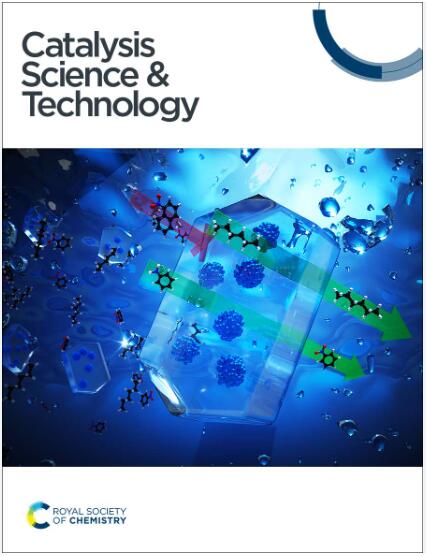ZnxCeO2纳米棒作为CO2转化为氨基甲酸酯的活性催化剂†
IF 4.4
3区 化学
Q2 CHEMISTRY, PHYSICAL
引用次数: 0
摘要
二氧化碳是一种无毒的、常见的气体,可以转化为有用的化学物质,如碳酸盐、氨基甲酸酯、聚氨酯、替代脲、甲醇和碳氢化合物。我们发现CO2与乙醇胺的环加成是制备环氨基甲酸酯的重要方法。本研究的主要目的是开发一种稳定高效的催化剂,为CO2和乙醇胺直接合成2-恶唑烷酮提供良好的选择性。CeO2纳米棒(CeO2 r)包含比立方和块状形式的CeO2更高的氧空位百分比。合成的Zn0.1CeO2催化剂进一步改善了氧空位的形成,提高了CeO2从Ce4+到Ce3+的表面还原性,从而促进了CO2和胺的活化。用原位红外光谱研究了乙醇胺和CO2在催化剂上的吸附随温度的变化。在最佳反应条件下,乙醇胺的转化率为93.5%,对2-恶唑烷酮的选择性为98%。本文章由计算机程序翻译,如有差异,请以英文原文为准。
ZnxCeO2 nanorod as active catalyst for CO2 conversion into carbamates†
Carbon dioxide, as a non-toxic and commonly available gas, can be transformed into useful chemicals such as carbonates, carbamates, urethanes, substituted ureas, methanol, and hydrocarbons. We have found the cycloaddition of CO2 and ethanolamine is a significant method for producing cyclic carbamates. The main aim of this study is to develop a stable and efficient catalyst that gives excellent selectivity for the direct synthesis of 2-oxazolidinone from CO2 and ethanolamine. The CeO2 nanorods (CeO2 r) comprise a higher percentage of oxygen vacancies than the cubic and bulk forms of CeO2. The synthesized Zn0.1CeO2 catalyst further improved the formation of oxygen vacancy sites and the surface reducibility of CeO2 from Ce4+ to Ce3+ thereby facilitating the activation of CO2 and amines. In situ FTIR has been used to examine the adsorption of ethanolamine and CO2 on the catalyst as a function of temperature. Under the optimum reaction conditions, excellent conversion of ethanolamine (93.5%) and outstanding selectivity towards 2-oxazolidinone (98%) were achieved.
求助全文
通过发布文献求助,成功后即可免费获取论文全文。
去求助
来源期刊

Catalysis Science & Technology
CHEMISTRY, PHYSICAL-
CiteScore
8.70
自引率
6.00%
发文量
587
审稿时长
1.5 months
期刊介绍:
A multidisciplinary journal focusing on cutting edge research across all fundamental science and technological aspects of catalysis.
Editor-in-chief: Bert Weckhuysen
Impact factor: 5.0
Time to first decision (peer reviewed only): 31 days
 求助内容:
求助内容: 应助结果提醒方式:
应助结果提醒方式:


